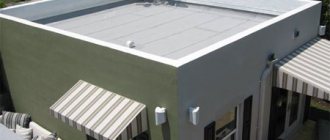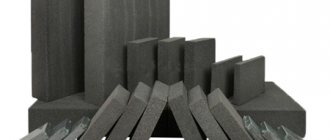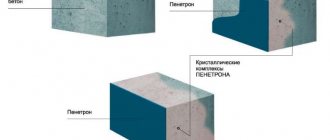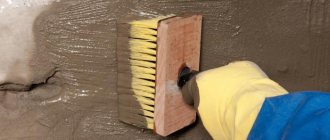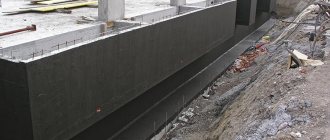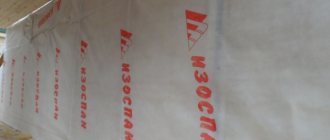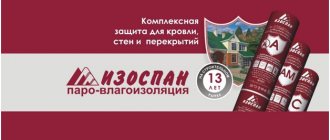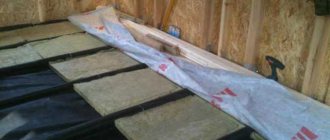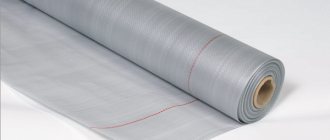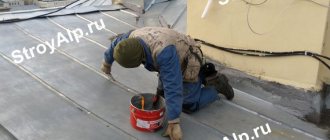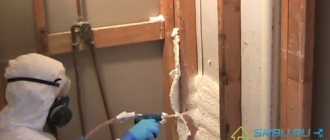0
4238
25.08.2013
Izospan materials are convenient and durable films for construction, having various purposes and application features. They are distinguished by high performance characteristics and, depending on the modification, can be used as a moisture-, steam- and wind-proof layer at almost any stage of construction or finishing work.
Technical characteristics of isospan
Types of Isospan
Let's start with what Izospan is. This is the trademark under which the Tver company Hexa produces non-woven building materials - films and membranes for various purposes. In short, there are vapor barrier, windproof and waterproofing roll materials. There are a lot of materials, so the names, applications and features are summarized in a table. It's easier to navigate this way.
Instructions for use of Izospan depend on the area of its application
As you can see, all Izospan materials can be divided into three groups:
- Wind protection. This is a group of Izospan A materials and varieties. These are materials that protect the insulation from blowing, retaining heat. At the same time, they remain permeable to steam, but do not conduct/permeate moisture.
- Steam-waterproofing materials. These are Izospan B, C, R and several of their varieties. They do not allow moisture to pass through in any form.
- Energy-saving vapor-waterproofing Izospan F. It is distinguished by the presence of a metallized layer; it does not allow moisture to pass through in any form - neither steam nor liquid.
There are also connecting materials - single- and double-sided connecting tapes on different bases. They are needed during installation and allow you to avoid deterioration of performance at joints. Some allow you to achieve tight connections.
How to distinguish by name
The name of the materials contains a key letter, by which the group and main properties can be determined. So Izospan A with all other indices means a vapor-permeable membrane. Izospan V, D, C - hydro-vapor barrier. The difference between the films of this group and the first is that these materials (B, C, D) do not allow steam to pass through. The materials of the first group (A) conduct it (steam) and retain only water. The exception is Izospan A base. It does not retain water and conducts steam.
Instructions for use depend on the type of material
The third group is also hydro-vapor barrier. It differs in that it has a metallized coating. The names of materials in this group contain the letter F: FD, FX, FS, FB, RF. They are used to more effectively retain heat, since heat rays are reflected from the shiny coating. But reflection is only possible if there is an air gap in front of the film of 3.5 cm (or more).
After the first letter in the Izospan marking there is often a second one. It describes the special properties of a material. It can also be an abbreviation or short word. For example, the presence of the letter M or S indicates the presence of reinforcement. The fix prefix means that strips of glue are applied along the edges, so there is no need to use tape.
Scope of application
Izospan can withstand force loads and not lose shape, and also withstand the influence of ultraviolet rays.
Izospan is used when carrying out work on internal insulation of premises. It is an excellent material for insulating wall structures and internal partitions; interfloor ceilings and floors in rooms where high humidity conditions prevail; as a substrate for laminate or parquet; for roof insulation.
Its demand for roofing work is due to the fact that if the film is absent from the roofing pie, then the thermal insulation layer will not be able to perform its function. Under the influence of condensation, it will quickly become wet and require replacement. Creating a vapor barrier layer from Izospan allows you to avoid this.
Izospan A: instructions for use
Group of materials Izospan A - vapor-conducting windproof membranes that do not conduct liquid water. The exception is Izospan A base. This membrane is only wind protection. It does not interfere with the passage of steam and water. Used in the ceiling above a ventilated facade, stuffed from the underground side. Protects mineral wool from blowing and does not interfere with the removal of moisture from the insulation.
To understand where and how best to use Izospan A, look at the characteristics. Once again: the film is not blown (retains heat), removes steam, and does not allow water to pass through. These properties are needed in the following constructions.
Rules for laying and installing windproof, vapor-permeable membranes
Vapor barrier materials are laid on vertical, inclined and horizontal surfaces. Despite the fact that the designs are different, the installation rules are no different. Here's what to remember:
The basic rule of installation is to make overlaps and carefully glue them
- On pitched roofs and walls, work begins from below. On horizontal roofs - from one of the walls.
- The second layer of material is laid overlapping. That is, one panel overlaps another by no less than:
- 10 cm on walls;
- 15 cm on roofs;
- 15-20 cm in overlaps.
- Vertical joints (if any) have the same dimensions.
- All connections of the canvases are glued using double-sided adhesive tapes.
- The connection to the walls and rafter system is also glued. To adjoin the rafter system, it is recommended to use self-adhesive sealing tape Izospan. For joints - KL, for adjoining the structure KL+.
The task of vapor-permeable waterproofing and windproofing is to allow steam to pass through, but not to allow moisture to enter in a liquid state. Therefore, the strength of the joints is important.
On a pitched roof, on top of insulation
The vapor barrier is laid on top of mineral wool and covered with any roofing material. Let's see how everything works. Here it is necessary that the steam that gets into the insulation from the attic is removed. At the same time, condensation and possible leaks did not enter the insulation. So you need to remove steam and not let water through. This is what Izospan A does.
Application of Izospan A in an insulated pitched roof
The membranes are turned with the logo facing towards you. It is better to lay it not under tension, but with sagging. In this case, condensation, which cannot be avoided on the roof, will flow into the center, and then into the gutter of the drainage system. This way it will dry out faster even in damp times, moisture will be retained less, and there is less chance of it getting into the insulation.
On top of the vapor barrier, slats are placed along the rafters, and then across the sheathing for installation of the roofing material. With this device and the presence of ventilation holes in the roof, the vapor barrier will be blown and dried.
In frame walls on the street side
Typically, indoor humidity is higher than outdoors. And no matter how much we protect the walls, steam leaks into them. These are the laws of physics. And since he hit the wall, he needs to be taken out. So the task here is the same - to let off steam. This can only be done from the street side. So Izospan A in frame walls is also placed on the street side. Here you can use all types of Izospan A, except for the “base”.
Izospan A - instructions for use in a frame wall
When using Izospan A “in its pure form”, it does not matter which side it is laid on. We unfold all other modifications - AS, AQ, AM - so that the logo is facing out.
When insulating walls with mineral wool and for ventilated facades
With external insulation of walls, in ventilated facades, the situation is almost the same as with the frame. Some moisture is seeping into the wall from the room. Then it penetrates into the insulation. Since wet mineral wool is a poor insulator, care must be taken to ensure that this steam is quickly removed. At the same time, it is necessary to protect the cotton wool from getting wet and retain heat as much as possible. That is, the problem is solved by the same vapor-permeable membranes of the Izospan A group.
Application of Izospan A for external wall insulation and in the system of ventilated facades
Any vapor barrier for use in the case of external wall insulation, except Izospan A with OZD, AF+ and base. The installation rule is the same - turn it with the logo facing you. For use in ventilated facade systems, Izospan AF+ is recommended. If a metal structure is used, its strength will ensure that the vapor barrier will not break. If the ventilated facade is covered with wooden blocks, Izospan AM, AS and AQ in any of the options may well be suitable.
Ceiling over a ventilated subfloor
The floor insulated with mineral wool over a ventilated base has its own characteristics. First and most important, for the scheme to work, the subfloor must be ventilated. This means that there must be vents in the foundation. And they must be open even in winter, otherwise you will have wet insulation and cold in the house.
How does this pie work? From the side of the house, moisture and steam seep into the insulation. If you simply line the insulation with mesh or slats, the wind blowing underground will do an excellent job of removing moisture. But at the same time, it will carry away heat and gradually remove mineral wool particles, reducing its thickness. To get rid of heat and insulation from escaping, Izospan A base vapor barrier is used. It allows steam and moisture to pass freely in both directions, but does not allow wind to pass through.
Izospan A: instructions for use in the ceiling above a ventilated subfloor
The following objection may arise. Moisture from the soil will evaporate and enter the insulation. Under certain conditions, it condenses on the membrane, causing the insulation to become wet. Maybe it’s better to use a vapor barrier with waterproofing properties? No. This won't work. If the membrane does not conduct moisture, then the moisture that condenses or gets into the insulation will remain there. Because it will not heat up enough to evaporate and be released as steam. In a couple of years you will have bags of water hanging from the ceiling and completely wet and unusable insulation.
And in order to reduce the evaporation of moisture from the soil, a dense film is placed in the underground, a layer of sand (any kind, but without clay and dust) is poured on it in a layer of 5-10 cm. The film retains most of the moisture, and the sand works as an adsorbent, absorbing fallen condensate. It (the sand) is also dried by the passing wind.
Interfloor and attic floors
In ceilings, steam enters from below and must be discharged from above. Therefore, a vapor barrier is placed at the bottom to protect against moisture, and a vapor-permeable wind barrier is placed at the top. In this case, it also additionally protects against the penetration of mineral wool particles into the room. You need to put Izospan in the same way - the logo should be facing you.
Izospan A for flooring - in interfloor and attic floors
In the interfloor ceiling, to reduce the cost, vapor-permeable Izospan can be replaced with non-woven material (any type of geotextile). Its main function here is to protect against the penetration of small mineral wool particles into the air. But you can do this only if the flooring is sheet material in two layers, with the seams spaced apart. Otherwise, moisture may seep in and then simply the non-woven material will not protect the insulation from getting wet.
In the attic floor, such a replacement is not considered at all - here it is also necessary to protect the heat from weathering. So wind protection is necessary here.
Also note that the vapor barrier is attached to the beams with counterbattens. And the flooring is already laid on them. Counter rails are needed to create a ventilation gap, which is a prerequisite for moisture evaporation. It is important.
What is Izospan - what is it for?
Izospan is widely known today on the Russian building materials market; it is a domestic brand manufactured in the form of a membrane film and has a wide range of applications. It is an excellent means of protecting against moisture from both outside and inside the room.
Characteristics of Izospan
Izospan is an effective protective agent against moisture of any type: water, steam, condensation, etc. It comes in different types, depending on this, some types are used to protect the insulation in the roof, others are used to protect the cold roof structure. In addition to all this, it serves as good waterproofing for walls, interfloor ceilings, and on basement floors - in concrete and other moisture-absorbing floors.
There are several varieties of it, each of which has its own functionality.
What is Izospan
Instructions for using vapor barrier Izospan V, C, D
Izospan vapor barrier films are also waterproofing. They do not allow water or steam to pass through. What are the differences between Izospan A and B? The fact is that B does not let steam through, A does. That's it in short.
Made from different materials. There are films, nonwovens and fabrics made of polyethylene and polypropylene. Fabric-based materials have very high strength characteristics. Their use is justified in places where they may be subject to high mechanical loads. Technical characteristics of Izospan vapor barrier films are given in the table.
The main task of these materials is to cut off steam from the insulation as efficiently as possible and at the same time provide protection from moisture. A “side” but important effect is protection against the penetration of mineral wool particles into the indoor air. It is used in the construction of walls, ceilings, roofs, and when constructing concrete floors. Vapor barriers are often part of the “pies” above, simply because they perform other tasks.
Rules for installing vapor barriers
The main task when laying vapor barrier films is to achieve as complete a seal as possible. It is necessary to let as little steam as possible into the insulation. We make all connections reliable using sealing and connecting tapes. The basic rules of vapor barrier do not differ from those described above:
- On the walls and roof we start from the bottom.
- The next canvas overlaps the first by 10-20 cm.
- We make vertical joints with an overlap of at least 20 cm. Vapor barrier materials are usually installed from the inside of the room
- We glue all connections with double-sided tape.
- We make connections to building materials using mounting and connecting tapes.
- When used for flat roofs and ceilings, the vapor barrier is applied to the walls and sealed there.
In addition to gluing the joints of the canvases, it is also important to use even strips-bars for final fastening of the material. They press the material tightly, sealing at the same time the holes that the fasteners invariably pierce.
Pitched roofs - insulated and non-insulated
Pitched roofs can be insulated or cold. In any case, a vapor barrier is installed on the attic side. It does not let steam into the insulation and this is its main task for this case. But Izospan is recommended differently for insulated and non-insulated roofs:
- for insulated roofing it is better to use RS, B or B fix, they differ in strength (RS is stronger);
- for non-insulated - D or D fix, DM (DM is stronger than just D).
Application of Izospan vapor barrier for roofing
Izospan RS and B films have one rough side and the other smooth. So, Izospan V and RS should be turned with the rough side into the room. We unfold the smooth one towards the insulation or roofing material.
Flat insulated roofs
When insulating a flat roof, a vapor barrier is laid on the ceiling under the insulation. The purpose of this layer is twofold. On the one hand, do not let steam into the insulation, on the other, cut off moisture from the ceiling in the event of a leak.
How to use Izospan when insulating a flat roof
In this case, it is recommended to use Izospan D and RM, RS. They have sufficient strength to withstand the loads that will certainly arise when laying insulation.
Izospan B: instructions for use for walls
In frame walls, Izospan V vapor barrier is installed on the side of the room. The task of vapor barrier is to let as little steam into the insulation as possible. Whatever gets into it (and it will definitely get in) will come out, since there is a vapor-permeable Izospan A film on the outside. But the less moisture there is, the better.
Izospan A and B - instructions for use for frame walls
In this case, Izospan RS (RS) and B are recommended for use. The strength of RS will be required only if you are planning a break in work and the cladding will be mounted on the walls after some time. The smooth side of Izospan B goes to the insulation, the rough side is directed into the room. This is the basic rule.
Please note that in the diagram Izospan B is nailed to the racks with strips, and sheet wall covering material is mounted on the sheathing strips. This option is good because it allows you to use a strip to isolate the holes made by the fasteners. There is another option - you can attach the film to the stands using a stapler and staples with wide backs. The inconvenience is that the rack will not be visible and it is unclear where to attach the sheet material. But the option is possible, although not ideal.
Attic and interfloor ceilings
A vapor barrier in a wooden floor pie is needed from the lower room. If you look from bottom to top, the sequence goes like this:
- ceiling filing;
- vapor barrier (Izospan V);
- rough ceiling;
- insulation between beams;
- vapor-permeable film (Izospan A);
- floor laid on a counter-batten.
Which Izospan to lay on the ceiling side in the attic and interfloor ceilings
How does the vapor barrier work in this cake? It does not allow vaporous moisture to pass from the room into the insulation. If there is a leak from above, it will also retain moisture, but this is an emergency and the water will not hold for long.
Which side should Izospan B be placed in this case? The rough side goes into the room, the smooth side goes up. When installing, try to damage the panel as little as possible. If a hole has formed somewhere, seal it with tape. Branded is better, but you can also just use a good one, with a high-quality sticky layer.
Basement ceiling
The basement floor is built according to a completely different logic. Here steam will flow from top to bottom. From a warm room with humid air to a cooler and drier underground. And so that moisture penetrates into the insulation as little as possible, we put a vapor barrier on it (the thermal insulation). The steam that gets into the insulation will either fall on the ground in the form of drops, or will be carried away by the wind in a vaporous state.
Vapor barrier Izospan B and RS in the basement
Izospan B and RS are recommended for use. When laying, we turn the rough side towards the insulation, the smooth side faces the room. The films are laid on beams and secured with slats - counter-battens. The flooring is already being laid on them.
For better heat conservation, you can use vapor barrier materials with a metallized layer: RF, FS, FD, FX. In this case, the thickness of the counter rails is at least 35 mm. This is the minimum gap that ensures effective heat reflection.
Screed on concrete base
If it is necessary to level a concrete slab, a screed is often used. To prevent water from the solution from leaking into the ceiling, it is advisable to use waterproofing. This can be a coating or rolled material. The cheapest is film. But you will have to walk on it and it is unlikely to remain intact. Especially if the screed is reinforced. Is it possible to pour screed without film? If you are not afraid of flooding your neighbors below, then you can. Or if you use coating waterproofing. Without it, most likely, the screed will not have the required strength. A certain amount of moisture is required for the formation of cement stone. And it will partially go into the slab, and partially seep through the cracks. What the result will be is unknown. Accordingly, it is advisable to use film.
Application of waterproofing in floors on a concrete base
It is recommended to install Izospan D (D) or Izospan RM (RM) vapor barrier under the screed on a concrete base. These are waterproofing materials of increased strength. It doesn’t matter which side these materials are laid on. But Izospan D has very high strength and it makes sense to use it only if reinforcement will be laid. For a screed without reinforcement, RM is quite sufficient.
If there are significant depressions in the base, it is better to seal them; it makes sense to cut off humps that are too protruding. This will not only increase the chances of preserving the film, but will also make the screed thinner. And this is a significant saving.
Wind- and moisture-proof protective membrane films
Membrane films, used to protect structural and thermal insulation elements of buildings from weathering, sedimentary moisture and condensation, are made of polypropylene, known for its durability, environmental safety and resistance to various aggressive substances and microorganisms. Izospan windproof membranes have several modifications:
- Izospan A is a single-layer membrane with windproof and moisture-proof properties, used for thermal insulation of walls and roofs for wind and moisture protection of the insulation. The outer side of the film is smooth, with water-repellent properties, the inner side is porous, which ensures the removal of moisture from the insulation layer.
- The two-layer version - Izospan AM, is distinguished by a high-strength backup layer that protects the membrane film from damage during installation and operation. Has high water-repellent ability.
- Modification Izospan AF is a wind- and moisture-proof film with fire protection, made using membrane technology. Fire protection allows Izospan AF to be used in flammable wooden buildings, as well as for wind protection of flammable insulation materials.
- Izospan AS is a three-layer membrane film with increased water-repellent properties. Laying directly on the insulation layer is allowed, without creating a ventilation gap.
Table of Izospan varieties
Vapor barrier with reflective layer Izospan F
The third group of materials is vapor barrier films with the effect of heat reflection. They differ in that the outer layer is a metallized film (lavsan or polypropylene). They can be used instead of similar materials (vapor barriers) in all of the above structures. If there is an air gap, the material is able to reflect thermal radiation back into the room.
Energy-efficient vapor barrier Izospan F is installed on the side of the room. When installing, turn the shiny side toward the room. The use of this group of materials can reduce heating costs by about 10%, but there is still debate about this: not everyone believes in it.
Metallized vapor barrier Izospan
The second area of application for Izospan F is the underlay for finishing floor coverings. Under laminate, parquet boards, and film heated floors, it is recommended to use Izospan FX. This is foamed polyethylene 2-5 mm thick with a metallized film glued. In addition to reflecting heat, it also acts as thermal insulation. Any other material of this group can be placed under all other coatings.
Using Izospan F in a heated floor system
When laying a heated floor system in a screed, the cake remains the same. Only a pipe or cable is added. But they need to be laid according to a certain pattern, so a metal mesh is also needed. Water heated floor pipes or an electric heating cable are tied to it.
Which Izospan to use under heated floors
In order not to heat the ceiling of the neighbors below, it is advisable to direct the heat as high as possible. To solve this problem, insulation is laid on the slab, and waterproofing with a heat-reflecting effect is placed on it. In this case, the material does not allow water to enter the slab and reduces heat loss during operation. For heated floors, it is recommended to use Izospan RF, FX, FD, FS.
Roof vapor barrier
The installation of hydro- and vapor barrier of the roof begins from the bottom. When laying out the membrane material, do not allow it to come into contact with the thermal insulation. This will reduce the ability to withstand moisture. To understand what we are talking about, it is enough to imagine the following situation. Let's say a person goes on a hike. He took with him a canvas tent, which was used back in Soviet times. If you run your finger along the roof while it’s inside while it’s raining, then after a few minutes it will start to drip from that area. Izospan works in a similar way. It is always equipped with double lathing.
Izospan is installed outside, laid on a sheathing of slats. The membrane structure increases the degree of insulation. At the same time, it contributes to an increased service life of the structure as a whole. It is very important to prevent all kinds of swelling and sagging during the operation of the roof. Otherwise, you will have to listen to the sounds of the wind with characteristic sounds when the membrane knocks on the roof. The use of thin slats is enough to secure Izospan, leaving 3 cm to the insulation.
Izospan A, AM, AS, AQ proff, A with OZD
The line of hydro-windproof, vapor-permeable membranes includes non-woven materials of various densities:
- Izospan A (density indicator 110 g/m2) is the most permeable membrane of the entire line, it allows moisture to escape out, but does not let it in. When installing, it is necessary to leave a gap for ventilation.
- Izospan AM (90 g/m2) is a three-layer membrane. The technical characteristics of Izospan AM allow the installation of a protective hydro- and wind barrier without a ventilation gap, since air circulates between the layers of material and removes moisture.
- Izospan AS (115 g/m2) is also a three-layer diffusion non-woven material, but more dense than AM.
- Izospan AQ proff (120 g/m2) is a professional material. Izospan AQ proff has a three-layer structure with reinforced reinforcement. Use Izospan AQ proff. It is recommended if externally insulated walls or a roofing system will have to be left for some time without an external protective and decorative coating. Features of Izospan AQ proff - increased resistance to moisture, ultraviolet radiation, and mechanical damage.
- Izospan A with OZD - the material differs from Izospan A in the presence of fire retardant additives. A non-flammable membrane is used if welding work is expected to be carried out in close proximity to an insulated structure, for example, when installing ventilation facades.
Microporous membranes are made of two or three layers. Their characteristic feature is the different quality of the material on the front and back sides. One side is smooth, the other is rough. Hydro-windproof Izospan is laid to the insulation with the white side if we are talking about Izospan AQ proff, AM and AS membranes. In this case, the diffusion barrier Izospan A and A with OZD, according to the instructions, is mounted with the smooth side outward. The accumulated condensate should flow along it into the drainage drain.
Advantages and disadvantages
The official instructions indicate that this building material has a huge number of advantages. And it is true.
Among the main advantages of Izospan B are the following:
- light weight, which greatly simplifies the process of transporting and laying the film;
- high strength, providing resistance to mechanical stress and damage;
- the presence of a double-sided surface, which has a positive effect on the effectiveness of the construction film;
- unique technical characteristics that make Izospan V stand out from other vapor barrier products;
- ease of installation - the product can be installed using the simplest solutions;
- affordable price, thanks to which everyone can afford to buy this film for home decoration.
Latest developments of the company
The Izospan company does not stop there, constantly improving its products, imbuing them with a large number of positive qualities. New products include the following brands of insulating materials with corresponding installation instructions: FB, FD, FS and FX.
These types of waterproofing film have the entire list of required characteristics: protection from wind and condensation, gradual removal of moisture and steam, and also an additional layer that reflects excess infrared radiation. In the FD and FS brands, polypropylene is used as a raw material, in FX - polyethylene, and only Izospan FB is made on the basis of kraft paper.
Any of the above types of waterproofing film is a reliable screen for infrared radiation, since one side of the product has a metal coating. Izospan categories FB, FD, FS and FX are ideal for the following types of work:
- Installation of a shielding layer for floors or heating radiators.
- Installation of a layer of insulation in interior and interfloor ceilings.
- Installation of the interior arrangement of a sauna or bathhouse.
